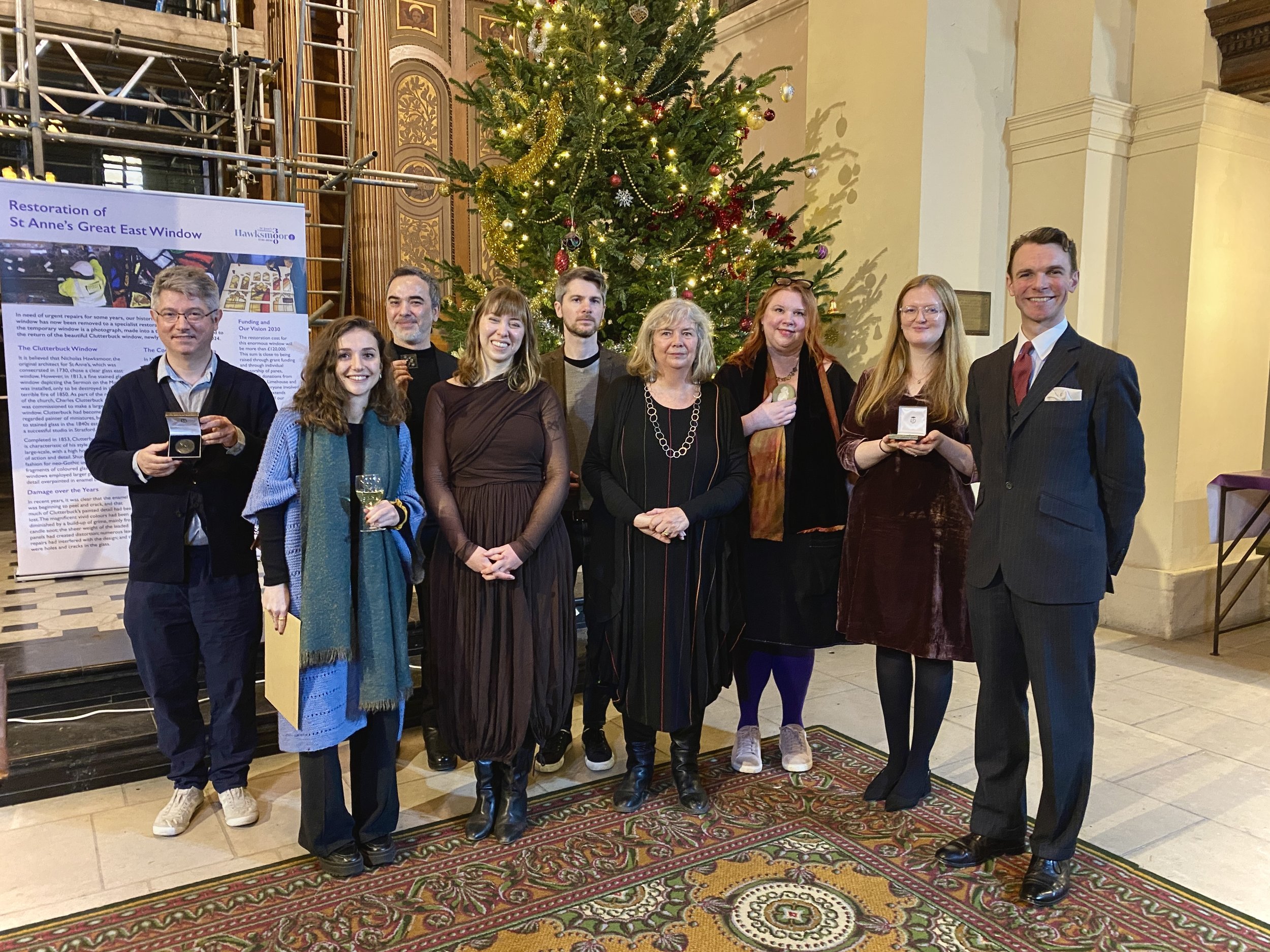Announcement of the 2024 SAHGB Award Winners
We are pleased to congratulate the winners of this year’s SAHGB awards.
Alice Davis Hitchcock Medallion
The Alice Davis Hitchcock Medallion – awarded since 1959 – is given annually to the author of a literary work that provides an outstanding contribution to the study of architectural history. The work must be by a British author (or authors), or deal with an aspect of the architectural history of the British Isles or the Commonwealth. The award is named after the mother of the American architectural historian Henry Russell-Hitchcock, and the medallion consists of a Wedgwood portrait of James ‘Athenian’ Stuart. It was presented to the SAHGB general meeting in 1959.
Judges: Dr Louise Durning, Prof. Iain Jackson, Dr Zoe Opacic, Prof. Florian Urban
Chair: Prof. Elizabeth McKellar, SAHGB President
Shortlisted:
Steven Brindle, Architecture in Britain and Ireland, 1530-1830 (Paul Mellon Centre)
Robyne Calvert, The Mack: Charles Rennie Mackintosh and the Glasgow School of Art (Yale University Press)
Finola O’Kane, Landscape Design and Revolution in Ireland and the United States, 1688-1815 (Paul Mellon Centre)
Christopher Tadgell, Architecture in the Indian Subcontinent: From the Mauryas to the Mughals (Routledge)
Winners:
Robyne Calvert, The Mack: Charles Rennie Mackintosh and the Glasgow School of Art (Yale University Press)
Citation: The Mack offers a remarkable new history of this most iconic of buildings through a forensic analysis of the new data gained from the many research projects undertaken after the first fire. This new evidence provides the empirical foundation of the book which includes the many insights revealed, not just through the old structure, but also in its re-making. Calvert is also concerned to uncover the emotional history of the building which introduces a welcome new strand to the biography of the site. In examining the life and death of a building the author raises important issues about the social meaning of conservation and restoration which resonate far beyond the Mack alone.
Steven Brindle, Architecture in Britain and Ireland, 1530-1830 (Paul Mellon Centre)
Citation: Based on John’s Summerson’s 1953 survey, this book offers an updated and revised account through a new emphasis on factors including social context, building production, technology and the importance of early nineteenth-century developments in British architectural culture. As its title suggests Brindle’s book also deploys an expanded notion of Britishness with coverage of Scottish and Irish architecture throughout the period. The judges praised its interweaving of individual case studies and themes within the broader historical sweep of the narrative which combine to produce a compelling account of early modern British architecture.
The Colvin Prize
The Colvin Prize is awarded annually to the author or authors of an outstanding work of reference that relates to the field of architectural history, broadly conceived. All modes of publication are eligible, including catalogues, gazetteers, digital databases and online resources. It is named in honour of Sir Howard Colvin, a former president of the Society, and one of the most eminent scholars in architectural history of the twentieth century. The prize was inaugurated in 2017; winners receive a commemorative medal designed by contemporary medallist Abigail Burt.
Judges: Sarah Akigbogun, Assoc. Prof. Laura Fernández-González, Dr Samantha Martin, Prof. Adam Sharr
Chair: Dr Elizabeth Darling, SAHGB Chair
Shortlisted:
Elain Harwood, Brutalist Britain. Buildings of the 1960s and 1970s (Batsford)
Jonathan Kewley, Isle of Man (Pevsner Buildings of England series) (Yale University Press)
Hamed Khosravi, Do you remember how perfect everything was? The Work of Zoe Zenghelis (AA Publications)
Editors: Sophia Psarra, Uta Staiger and Claudia Sternberg, Parliament Buildings. The Architecture of Politics in Europe (UCL Press)
Winner:
Hamed Khosravi, Do you remember how perfect everything was? The Work of Zoe Zenghelis (AA Publications)
Citation: The panel commended the book for the richness of its content and its carefully assembled mix of image and text. The book is notable for its documentation and celebration of an overlooked and significant practitioner in recent architectural history. Likewise, it draws attention to, and acknowledges, an under-appreciated mode of practice in its focus on Zenghelis’s use of painting and drawing. Finally, the panel commended the book for its accessibility to a wide audience, especially among future practitioners.
Hawksmoor Essay Medal
To encourage new and unpublished entrants to the field of architectural history, the Society's Essay Medal (popularly known as 'the Hawksmoor') is awarded annually to the author of the best essay submitted in competition.
Judges: Dr Emily Mann, Prof. Sussan Babaie, Prof. Christian Frost
Chair: Dr Doreen Bernath
Commendations:
Aleksander Musiał, The Pleasures of Antiqueereones: Speculative Antiquities and Rediscovering Hygiene Architecture in Charles Cameron’s Ancient Thermae Series (1767-1780)
Aoife Stables, The Art of Triumph: A Print of the Florentine Arch for the Royal Entry of Mary I into London, 1553
Winner:
Christopher Cowell, The Height of Health: Sections, Sanatoria, and Settler Colonialism in Northern India, 1815–1842
Citation: Amidst high quality entries, a number of which coincidentally have topics relating to health, hygiene and therapeutic architecture, the panel finds Christopher Cowell's winning work, 'The Height of Health', that intertwines geographical, medical, art and colonial settlement history most impressive, drawing on rigorous research that recast materials from the India Office Records at the British Library. The work is innovative in its interdisciplinary trace and sophisticated in its writing and argument, which are well positioned and developed from a range of textual and visual sources, as well as the sites. The spirit of innovative investigation in architectural history is carried through from the context of the altitudinal zones of settlement and sanatoria in the Himalayas across the C19th to the Roman baths and hygiene architecture of London and St Petersburg of the C18th, then further back to a surviving print of a triumphal arch as a precedent of pageant structure in England from the C16th. These are works from two other strong contenders, Aoife Stables' 'The Art of Triumph' and Aleksander Musiał's 'The Pleasures of Antiqueereones', which the panel wishes to acknowledge their merit by awarding them commendations.
Heritage Research
The SAHGB-IHBC Heritage Research Award recognises and celebrates the quality of architectural-historical research produced by colleagues in heritage and conservation practice, as private consultants and in non-departmental public bodies.
Judges: Kathryn A Morrison FSA, Henry Russell OBE, Matthew Saunders MBE, Sally Stradling FSA
Chair: John Cattell FSA IHBC
Winners:
Tim Howson, Market Cross, 25 Town Street, Thaxted, Essex (Heritage Asset Assessment, 2024)
Dr Christian Clarkson and Nicholas Uglow, Dalkeith Palace, Midlothian (entry draws on a recent Conservation Management Plan for the site)
Citation: John Cattell, on behalf of the judging panel, comments: “The panel recommends that this year’s award be made to Tim Howson IHBC for his exemplary analysis of the fabric of an important timber-framed building dating from the mid-14th century in Thaxted. Excellent use is made of detailed drawings, images and a clear and concise narrative to explain the complex development and phasing of the building. Its regional significance is clearly articulated, and the research is presented in a logical and scholarly manner. Additionally, the research sheds new light on the significant artistic contributions to the building’s interior by the Hunter family in the 20th century. The report will inform proposed alterations to the building.”
“The panel was impressed by Simpson & Brown’s accomplished research into the early 18th-century reconstruction around an earlier core of this important but little-studied Scottish Baroque building. In a highly compelling narrative, the authors draw out the contribution of the owner, Anna, Duchess of Buccleuch, to the rebuilding along with that of her architect, James Smith. The research makes excellent use of a wealth of documentary material in the estate archives and very clear phase plans to show the various changes. It will be indispensable to the client, the Buccleuch Living Heritage Trust, as it looks for a new tenant for the building.”
The Dissertation Prize
This prize celebrates the outstanding work in architectural history being carried out by postgraduate students on taught Master's-Level courses in UK universities. The prize awards innovative and critical thinking in and around the subject of Architectural History, broadly conceived, which supports the Society’s aim to help create a bigger discipline.
To acknowledge the differences in the educational and pedagogical structures at different courses, the Society has two distinct categories for the Dissertation Prize.
Category 1 celebrates Dissertations written as part of a taught MA / MSc course in Architectural History, Heritage or Conservation.
Category 2 honours dissertations submitted at MArch and MSc courses researching questions of architectural history as a broader field.
Category 1: For dissertations by students on taught Master’s-level courses related to architectural history and heritage
Judges: Dr Moa Carlsson, Dr Anne Hultzsch
Chair: Prof. Luca Csepely-Knorr
Commendation:
Kshiraja Krishnan, City of Limelight: The spatial production of cinema halls and late-colonial Bombay (1910-1933)
Winner:
Arielle Lavine, FOREST CHILDREN: How Educations of Indigenous and Settler Children Reinscribe the Colonial Order
Citation: An exceptional dissertation exploring the history of education systems linked to nature and land within settler colonial societies, handled with outstanding analytical, graphic, and emphatic skill. Specifically, it analyses two educational programs in Canada—the Indian Residential School and the Woodcraft Summer Camp—with divergent intentions, and reframes these as complimentary colonial strategies for territorial control and cultural colonisation, demonstrating, in the words of the author, that ‘Indigenous dispossession goes hand in hand with Settler possession’. We were particularly impressed by how the author linked the present debate about unceded lands, Indigeneity, truth, and reconciliation to a rigorous historical enquiry and a proposal for a future trajectory. Based on in-depth archival research and including a large body of analytical drawings, the dissertation contributes to knowledge not only about Canada but can also inform new readings of human interaction with ‘wilderness’ as an aspect of ongoing colonialities.
Category 2: For dissertations by taught Master’s-level students on accredited professional architecture (MArch) degrees
Judges: Richard Adetokunbo Aina, Dr Robert Proctor, Dr Lui Tam
Chair: Prof. Luca Csepely-Knorr
Winner:
Bianca Zucchelli, The Eel, The Dowry and The Seamstress
Citation: The jury found that this creative, well written and very enjoyable dissertation provided a unique perspective on gendered labour in historical contexts by recreating the life of a woman in a small Italian town in the mid twentieth century, integrated with feminist theories and interdisciplinarity. The innovative storytelling approach and presentation added a new interpretative layer to the dissertation.
The awards are overseen by the SAHGB to reward work that is innovative, ambitious and rigorous in tackling histories of the built environment as broadly conceived. The SAHGB’s awards programme is open and inclusive wherever possible, celebrating diversity of approach and recognising work at all career levels.
Please contact the SAHGB at info@sahgb.org.uk for further information.
The 2024 annual Awards ceremony took place at the church of St Anne’s, Limehouse, one of Nicholas Hawksmoor’s six London churches.
Philip Reddaway of Care for St Anne’s, has written more about its history and the plans to deliver a full restoration alongside the opening of new spaces and the churchyard to the local community.

